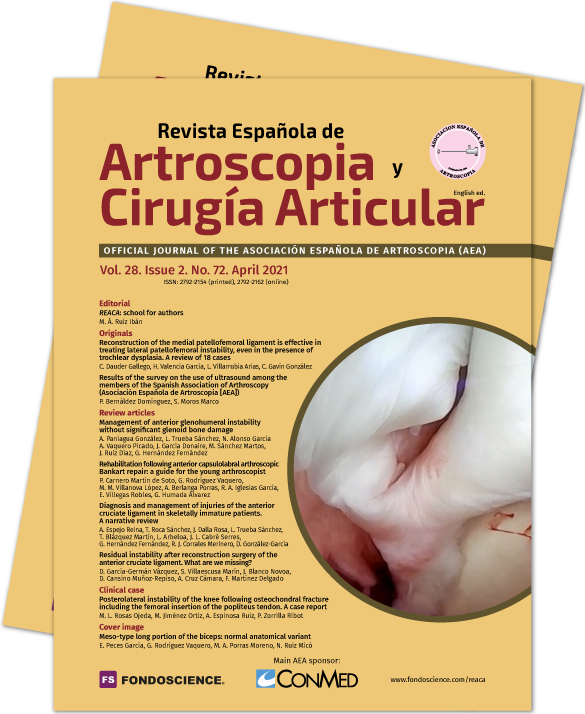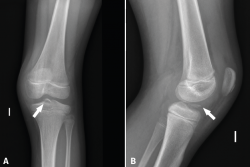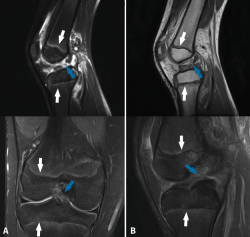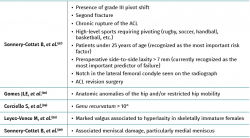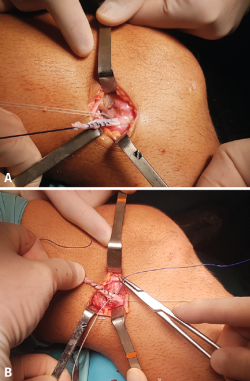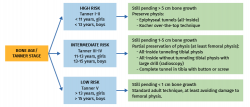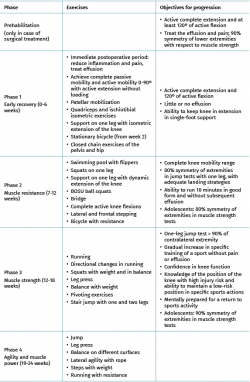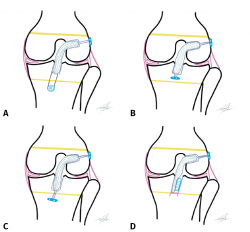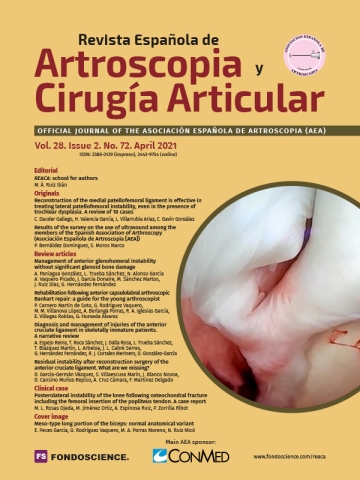Diagnosis and management of injuries of the anterior cruciate ligament in skeletally immature patients. A narrative review
Diagnóstico y manejo de la lesión del ligamento cruzado anterior en pacientes esqueléticamente inmaduros. Una revisión narrativa
Resumen:
La incidencia de lesión del ligamento cruzado anterior (LCA) en pacientes esqueléticamente inmaduros ha aumentado mucho en los últimos años, especialmente por el incremento en el nivel de exigencia a nivel deportivo cada vez a edades más tempranas, por la mayor incorporación de las mujeres al deporte de competición y por el aumento de la obesidad infantil; la presencia de hemartros se hace menos específica de lesión del LCA en comparación con la población adulta y la resonancia magnética es fundamental por su capacidad para valorar el estado madurativo de las fisis. Recientemente, han ganado importancia los programas de prevención, ya que han mostrado una importante reducción en la incidencia de rotura del LCA en esta población; también se ha demostrado que, cuando aparece la lesión, el tratamiento quirúrgico es la mejor opción para pacientes esqueléticamente inmaduros y se ha visto que su retraso incrementa las lesiones asociadas, como las meniscales y las condrales. El factor determinante en el tratamiento quirúrgico es la presencia de las fisis en este grupo de pacientes; por esto, se expone un algoritmo de tratamiento quirúrgico donde se elige la técnica en función del estado madurativo del lesionado y se tienen en cuenta otras consideraciones, como el tipo de fijación de la plastia y la necesidad o no de plastia extraarticular. Por último, se muestran los principales aspectos sobre el postoperatorio, la rehabilitación y la vuelta al deporte, que es el objetivo final del tratamiento de estas lesiones en los pacientes esqueléticamente inmaduros, retrasando cada vez más la vuelta a la competición de alta demanda.
Abstract:
The incidence of anterior cruciate ligament (ACL) injuries in skeletally immature patients has increased greatly in recent years, especially due to growing sports demands at increasingly younger ages, an increased number of females involved in competition sports, and the rise in childhood obesity. In such cases the presence of hemarthrosis is less specific of ACL damage compared with the adult population, and magnetic resonance imaging (MRI) proves crucial for assessing physeal maturity. Prevention programs have recently gained importance, since they have been shown to result in an important decrease in the incidence of ACL rupture in this population. It has also been seen that when the lesion appears, surgery is the best management option for skeletally immature patients, and postponing such treatment has been found to increase the associated lesions, such as meniscal and chondral damage. The determining factor in surgical treatment is the presence of the physes in this patient group. A surgical treatment algorithm therefore has been established in which the technique is chosen according to the maturity status of the patient, and other aspects are also taken into account, such as the type of plasty fixation and the need or not for extraarticular plasty. Lastly, a description is provided of the main aspects referred to the postoperative period, rehabilitation and the return to sports activities - this being the ultimate aim of the treatment of these lesions in skeletally immature patients, with increasingly longer postponement of the return to high-demand competition.
Introduction
The pediatric population is particularly vulnerable to injuries of the anterior cruciate ligament (ACL), due to the intrinsic characteristics of such individuals. In effect, these are very active subjects; their tissues are still immature (greater joint laxity(1) and less strength); they experience a lesser sensation of danger in the face of risk situations; and they are moreover less adherent to treatment.
An increase in injuries of the ACL has been observed among pediatric patients in recent years, representing 26-65% of all cases of hemarthrosis in the youngest athletes(2). This increase (up to 2.3% annually in the last 20 years)(3) is mainly related to the growing number of children involved in high competition pivoting sports, and to early sports specialization(4).
The management of ACL lesions in pediatric patients has been very controversial. Many surgeons are concerned about the possible growth alterations following reconstruction of the ACL, secondary to physeal damage caused by the surgical approach, tunnel drilling or the plasty fixation systems used(5). However, delaying surgery is associated to increased meniscal and chondral lesions(6).
Furthermore, the skeletally immature knee possesses anatomic characteristics that distinguish it from the adult knee - particularly the presence of physes and the size of the intercondylar notch. It is therefore essential to know the maturity status when treating ACL lesions in these patients.
The present review seeks to contribute to better understand lesions of this kind in younger patients, facilitate decision making and unify concepts and strategies.
Diagnosis
Epidemiology and anamnesis
The knee in children is subjected to high pivot and contact demands not strictly related to sports activities. Nevertheless, sports is the most frequent cause of ACL injury in children(7).
In the case of knee pain following trauma in a child, we first need to compile a detailed case history, seeking to identify the causal mechanism. The anamnesis and physical examination are usually influenced by the emotional stress of the patient, which can condition the initial diagnosis(8).
The gender of the patient is very important, since girls have greater laxity(1) and a greater risk of ACL rupture(4,9) and associated lesions(10), and more difficulty returning to sports activity(11).
Age is also crucial in relation to decision making, with lesser joint maturity (increased laxity)(1) and bone maturity being associated to a greater risk of growth disorders due to physeal damage. The peak incidence of ACL injuries is between 15-18 years of age, while the highest revision surgery rates are found in patients approximately 14 years of age(12). Sexual maturity (based on the Tanner classification)(13), the puberty growth spurt or the comparison of body height versus siblings and parents are determinant factors in choosing the treatment for these injuries.
Childhood obesity, which in Spain reaches an incidence of 40%(14), also favours ACL injuries(15) and an increase in associated lesions(16).
The time elapsed from injury to surgery is decisive, particularly in relation to the associated lesions: delaying surgery more than 12 weeks from the time of the accident increases the incidence of meniscal and chondral lesions(6,10). This delay has been associated not only to the making of decisions on the part of the supervising surgeon but also to the socioeconomic situation of the patients(17,18,19).
The most common mechanism of injury in young patients is valgus and external rotation in the context of indirect trauma to the knee during sports activity(20). The patient usually presents pain, swelling and instability sensation with certain movements of the knee. Having reached this point, it is important to distinguish between acute and chronic lesions, since pain and inflammation predominate in the former, and instability sensation in the latter.
Physical examination
The patellar tap test evidences the existence of hemarthrosis. However, in children under 12 years of age this association is not so important, since the appearance of isolated meniscal lesions is equally likely as the appearance of ACL injuries (47%) - in contrast to patients between 12-18 years of age, where this association is observed in 65% of the cases of ACL injury(21).
The specific tests used to explore ACL lesions in skeletally immature patients are no different from those used in adults. In this regard, the main tests are the Lachman test and the pivot shift test. The sensitivity of these tests may decrease due to the initial pain and limitation of joint balance. The exploration should be repeated after 2-3 weeks, once the pain and inflammation have subsided, and after full recovery of joint balance. In addition, this always should be repeated under anesthesia in the case of surgery, which is when the sensitivity of the physical examination is maximum: the sensitivity of the pivot shift test can increase from 35% in the consulting room to 98% under anesthesia(21). In acute lesions, the lever sign or Lelli test (Figure 1) has demonstrated greater sensitivity than the aforementioned tests(22).
reaca.28272.fs2007042en-figure1.png
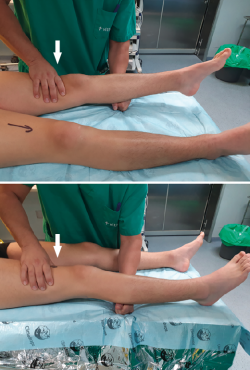
Figure 1. Negative Lelli test or lever sign of the left knee, with positivity of the right knee. In this test the examiner applies downward force immediately proximal to the knee joint, with the other fist beneath the proximal third of the calf muscle. With the intact anterior cruciate ligament (ACL), the heel should rise from the table (negative test). In the case of ACL rupture, the heel of the patient remains on the table, since the femur displaces posteriorly (positive test).
In addition to the diagnosis of the ACL lesion, we also must search for possible concomitant lesions: we should include meniscal provocation testing and also palpate both femoral condyles to discard possible osteochondral damage and assess competence of the extensor apparatus.
A lesion that is closely associated to damage to the ACL is the so-called lesion of the meniscal ramp of the posterior horn of the medial meniscus (though it has been little studied in skeletally immature patients). These lesions appear in about 25% of all cases(23) in the pediatric population with ACL injuries. A posteromedial port is crucial for establishing a correct diagnosis(23). Finochietto's sign (in the consulting room, under anesthesia and with arthroscopy) can contribute to the diagnosis of these lesions(24).
The knee in children is a much laxer joint than in the adult, and this should not be regarded as pathological. In all patients, regardless of their age, we must evaluate both knees in order to identify instability and not confuse it with hyperlaxity. In the case of pediatric patients this is even more important, however, since such laxity in these individuals is usually symmetrical, with no associated signs(1,25).
Complementary tests
Plain radiographs (Rx)
Although the findings are usually normal, plain radiographs can help discard other types of lesions. Tibial spine fracture (Figure 2) in children can occur with a clinical history and physical examination findings similar to those of ACL injuries(26). In addition, radiographs allow us to assess other lesions (epiphysiolysis, fracture-avulsion of the inferior pole of the patella or fractures of the tibial tuberosity) characteristic of pediatric patients(27). Therefore, anteroposterior under loading and lateral Rx views of both knees are needed in the case of suspected ACL injury.
In pediatric patients, Rx studies are essential to establish true skeletal maturity. The most widely used methods include Rx of the knee(28), of the hand(29,30) or of the pelvis, according to ossification of the iliac crest (Risser classification)(31), or elbow.
Magnetic resonance imaging (MRI)
Magnetic resonance imaging shows the physes in great detail in both the distal femur and in the proximal tibia (Figure 3), and is the best technique for evaluating them(30). The presence of the physes can complicate the diagnosis of ligament lesions in immature patients(32).
Magnetic resonance imaging allows precise assessment of the physeal condition of the patient(33). Physeal closure is directly proportional to age, though there are differences according to gender(28). Physeal closure is 0% until 11 years of age, 5% at 12 years, 34% at 13 years, 53% at 14 years, 94% at 15 years, and 100% from age 16 (33): this means that growth is complete in girls at about 14 years of age and in boys at approximately 16 years of age. Furthermore, the central portion of the physis of the proximal tibia closes before the peripheral portion - this fact being important for positioning of the tibial tunnel in ACL reconstruction.
Magnetic resonance imaging is also useful for the diagnosis of less frequent disorders such as agenesis of the cruciate ligaments (2/100,000 children)(34) - a condition that is usually asymptomatic and is associated to other anomalies around the knee(35) that can contribute to its identification.
Ultrasound
Although there are authors who defend its usefulness(36,37), ultrasound has not been standardized as a diagnostic tool in ACL lesions, and no data are yet available in skeletally immature patients. Nevertheless, the development of this technique in our specialty and its performance in the diagnosis of lesions associated to ACL injuries(38) suggest that ultrasound will grow in importance in the near future.
Treatment
Treatment decisions in the case of a pediatric patient with ACL rupture should be made by consensus among the physician, the patient and the parents or guardians.
The objectives of treatment are to:
- Restore normal knee function and stability, allowing an active and healthy lifestyle.
- Reduce the existing impact or risk of impact of meniscal or chondral disease, and the possible degenerative changes, as well as the need for future surgeries.
- Minimize the risk of arrested growth and/or deformity of the femur or tibia.
There are four fundamental aspects in the treatment of lesions of the ACL: prevention, conservative management and - in reference to surgical treatment - repair and reconstruction.
Prevention
Prevention is a crucial part of management, given the deleterious consequences of such disorders in this particular age group. Prevention programs seek to reduce the number of patients that may suffer a first ACL rupture, and to reduce recurrent rupture in those who resume sports activities after injury; these programs are able to avoid up to 53% of all ACL lesions, with increased evidence of efficacy in the case of plyometric, strength and agility exercises(39).
Perhaps the most popular of these protocols is the 11 + Kids(40), endorsed by the Fédération Internationale de Football Association (FIFA), and which has been shown to be able to reduce injuries(41) and is cost-effective(42). Another resource for the prevention of sports injuries is the Skadefri(43), a webpage developed by the Oslo Sports Trauma Research Center; it encompasses a broad range of sports and comes with a mobile phone application (Get Set) that can be very useful for injured patients.
Although there is evidence of the capacity of these prevention programs to avoid injuries(39), much work remains to be done - particularly on the part of the sports clubs and coaches(44). The main barriers for implementing these programs were found to be a lack of motivation, the technical requirements of the coaches and the needs referred to time during training, follow-up and cost(45) - though the same study proposed measures that should be introduced promptly, since prevention programs have been shown to be more effective when introduced at earlier ages(46).
Conservative management
Historically, ACL injuries in children have been subjected to conservative management (physiotherapy, orthoses and restriction of activities) until close to skeletal maturity, when ACL reconstruction was performed using techniques described in adults(47,48,49). Delaying surgery avoids iatrogenic alteration of the physis and allows the patient to reach the psychological maturity necessary to comply with postoperative therapy(50).
However, more recent studies have reported poor and unacceptable outcomes with conservative management: recurrent instability persists that favours meniscal and chondral damage, early degenerative changes and high sports dropout rates(10). Ramski et al.(51) found that patients treated on a conservative basis had a 33.7-fold higher probability of suffering clinical instability, and a 12-fold higher risk of developing medial meniscus rupture. The probability of returning to sports activity was 91.2-fold greater in the group subjected to early ACL reconstruction. The possible factors contributing to these poor outcomes include both the significantly higher activity levels seen in the pediatric population and patient failure to adhere to the modifications in the level of activity after the injury(47,48).
Conservative management could be a reasonable option in partial lesions of the ACL in patients under 14 years of age with tears affecting only the anteromedial fascicle, and with low Lachman test and pivot shift scores at exploration(52). In addition, the patients would have to comply with significant or total activity restriction, with the understanding that recurrent symptoms of instability might inevitably require ACL reconstruction surgery(53).
Conservative management is not recommended in patients with clear functional instability or subjects with concomitant intraarticular lesions requiring surgical treatment(54).
It is essential to provide the child and parents with detailed information on the surgical and conservative treatment options, the risks and the benefits. Likewise, the sports aspirations of the patient must be taken into consideration when deciding one treatment or other(49).
Close and frequent monitoring of the child is required in the form of repeated MRI scans and clinical examinations until skeletal maturation, and we must remain alert to instability episodes and secondary intraarticular lesions that would constitute an indication for immediate surgery(55). In the study published by Kocher et al., 31% of the patients subjected to conservative management required surgical reconstruction due to persistent symptoms of instability during sports activity(52).
Repair of the anterior cruciate ligament in children: when, how and why
In recent years there has been renewed interest in the ACL repair techniques. This could afford some theoretical advantages with respect to reconstruction, such as preservation of the anatomy (insertion zone and morphology of the bands of the ACL, nerves and intrinsic cell population) and of some complex biomechanical properties of the ligament(56). In addition, recovery after such surgery seems to be faster and easier for the patient than following reconstruction(57).
Primary repair is only indicated in patients with femoral avulsion of the ACL - Sherman(58) type I or, in some cases, type II; the proximal extremity of the ACL has better vascularization(59) and healing capacity(60) - and who preserve good quality tissue. This situation is usually found in the subacute phase (i.e., between 2 weeks and 3 months after injury) or in chronic ruptures if the ACL is adhered to the posterior cruciate ligament(61). Different techniques are available for ACL repair (Figure 4).
reaca.28272.fs2007042en-figure4.png
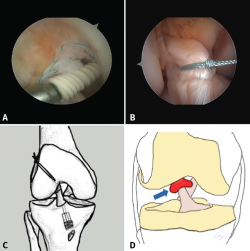
Figure 4. Repair techniques of the anterior cruciate ligament (ACL): A: repair without augmentation: reinsertion of each bundle using implants without knotting. Microfractures are incorporated in the implantation bed to improve biological repair; B: repair with static augmentation: the ruptured ACL is sutured and the ligament is moreover bridged with a 2.5 mm polyethylene band through the anatomic insertions of the ACL; C: repair with dynamic augmentation: a spring-type device is placed at the tibial insertion to maintain tension of the system throughout knee joint balance; D: repair with biological augmentation: a blood-filled extracellular matrix of bovine origin is interspaced (arrow) between the proximal extremity of the ACL and the bone.
However, in the specific case of the pediatric population, the results are not fully conclusive: Gagliardi et al.(62) recorded a 10-fold higher probability of recurrent rupture and a cumulative three-year incidence of close to 50% in patients with repair versus patients with reconstruction, while Dabis et al.(63) observed no complications or failures over the short term (2 years) in 20 patients between 6-16 years of age subjected to direct repair surgery. The repair of ACL rupture in the pediatric population is an attractive option. However, based on the current state of development of the different techniques, it is not possible to establish a clear recommendation in favour of such surgery, and if this type of treatment is decided, the risks must be very carefully explained to the patient and family.
Reconstruction
Reconstruction is currently the treatment of choice in most pediatric cases. The different surgical techniques can be divided into two main groups according to whether they preserve the physes or not. In this section we will review the available techniques and different considerations regarding the choice of graft, the fixation systems, and the extraarticular plasties.
Techniques
Techniques that avoid the physis
The physis lesion rates are much lower with these techniques, and the long term studies evidence few growth alterations(64). There are two subtypes of these techniques, according to whether bone tunnelling is performed or not:
• Epiphyseal techniques (all-epiphyseal procedures). Bone tunnels are made in the distal epiphysis of the femur and proximal epiphysis of the tibia, without perforating their respective physes. The first epiphyseal technique was described by Anderson(2) (Figure 5A), using quadruple ischiotibial autografts with bone tunnels made under radioscopic control. Femoral fixation is made with a suspension system, and tibial fixation is carried out knotting the plasty sutures to a screw anchored distal to the physis and medial to the tibial tuberosity. The modified technique of Cordasco-Green(65) (Figure 5B) uses a suspension system also for tibial fixation, in order to avoid the complications of the distal screw in the tibia or of an interference screw.
reaca.28272.fs2007042en-figure5.png

Figure 5. The most widely used techniques for reconstruction of the pediatric anterior cruciate ligament (ACL). A: epiphyseal technique with fixation screw distal to the physis (Anderson)(2); B: all-epiphyseal technique with cortical suspension systems (Cordasco-Green)(65); C: partially transphyseal technique with cortical suspension systems in which the tibial physis is only tunnelled with the needle and retrograde drilling is made to the physis, without damaging the latter; D: standard technique preserving the femoral physis and tunnelling the tibial physis, attempting to position the interference screw proximal to the physis.
Wall(66) described a technique involving a double epiphyseal tunnel in the tibia and fixation in the femur with a screw. The double tibial tunnel allows the creation of a bone bridge (minimum 1 cm) that ensures tibial fixation without the need for an implant. Espejo-Reina et al. have likewise described a double tibial tunnel technique(67) (epiphyseal in the case of the proximal tunnel and diaphyseal in the case of the distal tunnel) to bridge the physis and avoid fixation systems in the epiphysis, due to the space limitations that are often found.
The epiphyseal techniques are not without a risk of damaging the physis. Early femoral physis closure rates of about 15% have been described(68,69). Wong et al.(70) concluded that any type of technique has its risk of physeal damage.
• Extraphyseal techniques. These techniques are carried out without bone tunnels. Micheli(71) and posteriorly Kocher(72) described the first technique destined for pediatric patients, using as plasty a portion of iliotibial (IT) band, preserving its distal insertion. By means of a combined extra- and intraarticular reconstruction, the portion of the IT band runs superficial to the lateral collateral ligament (LCL) towards an over-the-top position in the femur to enter the joint through the posterior intercondylar zone. Finally, after passing beneath the intermeniscal ligament, it is sutured in the periosteum of the anteromedial surface of the tibia.
Willimon(73) recorded a low reoperation rate with the technique of Micheli, without physeal alterations and with a return to the pre-lesion level of activity on the part of the patient. Kocher(74) recorded a satisfactory course in 240 knees, without growth alterations and with a low plasty rupture rate (6.6%). Nevertheless, this procedure also has disadvantages, such as the technical difficulty involved, the fact that it is a non-anatomic technique, and the production of lateral asymmetry at the IT band donor site in a large percentage of cases, without minimizing the high morbidity of the technique.
Techniques that perforate the growth physis (transphyseal techniques)
Tunnels are perforated in both physes (femur and tibia) in these techniques (Figure 5 C and D). These procedures are similar to those used in adults. The partial transphyseal technique is a hybrid procedure in which only one of the physes is tunnelled - normally the proximal tibial physis (Figure 6A). Since the tibial tunnel lies more perpendicular to the physis, the affected area is smaller, and the possible impact is considered to be minimal. Milewsky and Nissen(75) published their hybrid technique with good outcomes, though the patients presented dysmetria (1.2 and 2.2 cm). In a series of 24 patients, Chambers(76) reported four cases of physeal lesions and concluded that the procedure should be avoided in the youngest patients (Figure 6B).
reaca.28272.fs2007042en-figure6.png
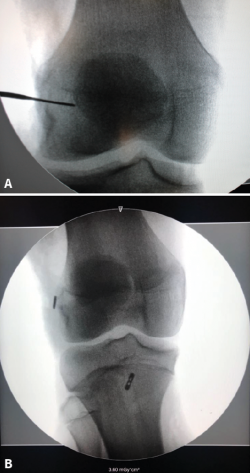
Figure 6. Intraoperative radioscopic view of a reconstruction of the anterior cruciate ligament (ACL) in a skeletally immature patient with the partial transphyseal technique. A: the entry point of the femoral tunnel distal to the physis is marked by a metal tip; B: postoperative control of the partial transphyseal technique, showing the cortical button of the femur in the distal femoral epiphysis and the tibial button located distal to the physis, in a more central location, to perform a more vertical tunnel and reduce physeal damage.
Considerations regarding grafts in reconstruction of the anterior cruciate ligament in pediatric patients
The choice of graft is a key issue in all reconstructions of the ACL, especially in pediatric patients. Different options have been proposed, including ischiotibial plasty, IT band, patellar tendon, quadricipital tendon, allograft or parental donor tendons - each with its own particularities.
The plasty of choice is predetermined by the chosen surgical technique, and the latter in turn is conditioned by the age and bone maturity of the patient. Goosefoot tendon grafting is the most commonly used option, since there is great experience with its use, no bone blocks are left in the physis, and it facilitates the all-inside technique with two cortical suspension systems. The problem with this graft is that the thickness of the plasty is predetermined by the height and weight of the patient(77); in some cases the graft therefore may be too thin. Thus, the use of a quadricipital tendon graft without bone block has been proposed, with excellent results, similar to ischiotibial plasty(78). Nevertheless, a recent review of the national registry in New Zealand concluded that the thickness of both the ischiotibial plasty and of the patellar tendon does not affect the ACL plasty failure rate in young patients (under 20 years of age)(79). Some authors recommend supplementing the procedure with allografting and producing a hybrid graft of greater thickness(80) - though caution is required with this recommendation, since high recurrent rupture rates of these plasties in adult patients have been reported(81).
In skeletally immature patients we avoid the use of bone-patellar tendon-bone plasty, since the bone block may become interpositioned in the physis and cause epiphysiodesis.
In recent years, the use of parental live donor grafts has been proposed, offering the same benefits as allografting in terms of low morbidity, but with much fewer complications. These are ischiotibial grafts (only semitendinosus) of the parents in the same surgical step. This reduces the recurrent rupture rate, since it involves live tissue with the same mechanical properties; we avoid damage to the donor zone of the child; and the patient tendons are preserved for possible future revision surgery - in addition to ensuring adequate plasty thickness for the operation(82).
Plasty fixation systems
These systems depend on the technique employed and on the maturity status of the patient. It has been seen that femoral fixation with a suspensory button system does not differ significantly from fixation with an interference screw in relation to peak loading and cycles to failure(83). However, interference screws are not advised as fixation system in techniques that tunnel the physis, due to possible damage to the latter; they therefore should be contemplated in epiphyseal techniques. The suspensory button system is advised in techniques that tunnel the physis.
With regard to tibial fixation, suspensory fixation is recommended in the epiphyseal techniques or in partially transphyseal procedures. However, in advanced maturation stages we can use an interference screw as fixation system, due to the lesser incidence of growth anomalies involved - though it has been shown that there is an increase in local symptoms with this fixation system in one out of every 10 reconstructions of the ACL in young patients, with a 5% reoperation rate because of them(84).
Anterolateral extraarticular plasties
Isolated reconstruction of the ACL might not suffice to restore the knee to its pre-lesion state(85), and adding an extraarticular plasty to this operation provides better clinical outcomes with a decrease in recurrent rupture rate of up to 43%(86).
The main indications for combining a lateral extraarticular plasty were described by Sonnery-Cottet et al.(87); however, other indications have subsequently been incorporated(86,88,89,90) (Table 1). The main techniques for anterolateral reinforcement plasties may be non-anatomic (Arnold-Coker, modified Lemaire and Kocher-Micheli) or anatomic (reconstruction of the anterolateral ligament [ALL]):
• Arnold-Coker technique (modified MacIntosh). Use is made of an IT band plasty released proximally and left anchored distally. After passing it under the LCL, it is folded and sutured onto itself at the level of Gerdy's tubercle(91), avoiding the femoral tenoepiphysiodesis effect associated to the classical MacIntosh procedure(92) in children, with proximal fixation to the physis.
• Modified Lemaire technique. This is the most popular procedure, and a number of modifications have been developed. Use is made of an IT graft of sufficient length to allow it to be passed beneath the LCL for insertion in the femur, posterior and proximal to the epicondyle(93), though we must be very careful with the femoral physis. Some authors recommend positioning it in the femoral tunnel itself, under radioscopic control(88,90), thereby reducing the risk of physeal damage. Another modification involves suturing the plasty to the same femoral button as the ACL(88) (Figure 7).
• Kocher-Micheli technique. Already previously described among the extraphyseal techniques, this procedure combines reconstruction of the ACL with anterolateral reinforcement in the absence of bone tunnels. The objectives are to minimize the risk of physeal damage, facilitate revision surgery, preserve the traditional autografts and contribute an additional rotational stabilizer. The technique is an excellent option for the repair of ACL rupture in prepubertal athletes. The author considers the ideal patient profile to correspond to Tanner stage 1-2, boys < 12 years of age or girls < 11 years of age(72).
• Reconstruction of the ALL. The ALL has been anatomically described in pediatric subjects; its insertions have been shown to be in close relation to the femoral physes (10 mm distal on average) and tibial physes (9 mm on average)(94,95). Many techniques combine anatomic reconstruction of the ACL and ALL(96,97,98) in adults, not specifically in pediatric patients - though it has been shown that the indicated tunnels can be made safely(99). The lesser recurrent rupture rate and improved functional outcomes in adults(87,100), together with the high ACL plasty failure rates in skeletally immature patients(101,102), suggest that in the future the use of anterolateral reinforcements will increase in this population group.
Other technical considerations
Pediatric patients are characterized by a smaller intercondylar notch. However, routine intercondyloplasty (notchplasty) is not recommended in all patients, since it implies variation of the biomechanics of the knee (increased anterior translation of the tibia and reduction of plasty strength at low degrees of flexion) with at least 3 mm of resection(103).
On the other hand, the incidence of meniscal ramp lesions is similar to that seen in adults. Revision is therefore advised through the intercondylar notch in the posteromedial compartment, in view of its high incidence, with due repair if found, since it affects the biomechanics of ACL reconstructions(23).
Surgical treatment algorithm
In selecting the surgical technique, it is advisable to evaluate the skeletal and bone maturity of the patient. Pediatric patients amenable to ACL reconstruction surgery can be stratified according to the risk of growth alteration due to physis damage (Figure 8).
The main problem of ACL plasties in pediatric patients is not the alteration of the physes and the consequent growth discrepancies but the high recurrent rupture rate of the plasties. For this reason, the most important need is a correct surgical technique with adequate placement of the tunnels, and to repair the associated meniscal and chondral lesions, if possible, in order to improve the stability of the knee and combine an extraarticular plasty if considered necessary.
Figure 7 shows an interventional algorithm according to the maturity status of the patients. There is no current consensus regarding the surgical technique of choice. Excellent outcomes with an adequate return to sports activities and a low incidence of failures and physeal damage have been obtained with all-epiphyseal techniques in the youngest patients; however, there is a greater risk of limb overgrowth(104). Likewise, it has been demonstrated that the over-the-top technique also affords excellent results, though with a greater angular deformity rate(105).
Considering the above, it is advisable to individualize each case and assess the maturity status of the patient in order to optimize the surgical technique. The epiphyseal or partially transphyseal techniques are more similar to the ligament reconstructions in adults; the surgeon therefore may feel more comfortable working with these options. Most ACL ruptures in children occur in adolescents with less than one year from closure of the physis(12). This allows hybrid transphyseal reconstruction with a minimum risk of physeal damage. For this reason, and in view of its lesser technical difficulty, it is the most common option. Likewise, the current development of suspension systems and retrograde drill design, with the aid of intraoperative radioscopy, allow the minimization of bone and physeal damage with this surgery.
Postoperative protocol and rehabilitation
Rehabilitation must restore the dynamic stability of the knee(106); it should be exhaustive and individualized according to the physiological and psychological maturity of the child in order to secure good outcomes, and the parents or guardians must participate actively in daily rehabilitation(26). Specific adjustments will be needed according to the surgery carried out, the type of graft used, and the associated lesions.
The functional objectives must be modified and not copied from the protocols applicable to adults. Rehabilitation programs for children under 12 years of age(26) should make use of leisure exercises and variations in order to avoid boredom; isokinetic and jump tests on one leg (with caution); and the placement of greater emphasis on the quality of the movements than on the leg symmetry index. Rehabilitators with training and experience in this population group are required.
Use of orthoses and crutches
The effectiveness of orthoses in the postoperative period after ACL reconstruction is not known(107). Nevertheless, their use can be recommended during the prehabilitation phase and after surgery, during 2-6 weeks, until the objectives of the first phase have been reached - particularly in view of the usually poor adherence of such young patients to the strict care requirements. Orthoses can also be used to prevent hyperextension, control varus / valgus, enhance patient awareness, and provide protection against possible falls or impacts with other children. In patients subjected to ACL repair surgery, extension orthosis is maintained during two weeks(108).
With regard to the use of crutches, there are a number of recommendations, depending on the protocol used. The most widely accepted recommendations are:
• Isolated reconstruction of the ACL. Most guides advise assisted full loading during the first postoperative week, with progression conditioned to patient tolerance until full loading is reached after four weeks(109). In 1998, Tyler et al. concluded that there are no deleterious effects in relation to stability or function in initial assisted loading in isolated reconstructions of the ACL - anterior pain being less intense in this group due to greater stimulation of the vastus medialis muscle(110).
• Associated meniscus repair. There are two tendencies in this regard: the recommendation to avoid weight-bearing for 4-6 weeks on one hand, and the allowance of initial complete loading with the use of an extension immobilizer during the first 3-4 weeks on the other hand. In any case, flexion should be limited to 90º during the first 4-6 weeks. Articulated orthoses may be used for this purpose and, if early weight-bearing is allowed, it should be done in full extension.
Rehabilitation phases
Four postoperative rehabilitation phases(111) and a prehabilitation phase(112) have been established in the case of surgical treatment for ACL rupture (Table 2). In the two cases (i.e., operated upon or not), the reference of progression through the objectives is similar in both groups. However, there are different expectations in terms of progression and in the time to fully return to sports activities. In all cases we must be guided by clinical and functional objectives, and the return to sports activities will be conditioned to reaching these objectives(113).
In order to move from one phase to another we must reach the objectives established in each phase. The objective in the first phase is to achieve rapid functional recovery and important muscle activation. In phases 2 and 3, the objective is to ensure adequate alignment of the extremities, together with correct support and loading techniques. Finally, in phase 4, secondary prevention measures to avoid new injuries are established, and we seek to reach neuromuscular functional stability before the return to sports activity.
Return to sports activity
In patients not operated upon, the return to sports activity is estimated to take between 3-6 months, while in the case of surgical patients the minimum period is 9 months. Nevertheless, in the latter patients, it is advisable to wait for 10-12 months after surgery (in those individuals subjected to repair, a period of 5 months has been proposed(108), though the evidence is very limited). Following ACL reconstruction, the estimated percentage of patients that return to sports activity in the first 9 months is 50%, and this figure increases to 85% at one year after the operation(114). The return to activity is conditioned by the type of sports, and should be made on an individualized basis for each patient.
The risk of recurrent ACL rupture in those patients who return to high-risk activities (pivoting and jump sports) is greater in children, particularly during the first 12 months(115). Consequently, some authors even advise waiting for two years before returning to high-risk sports activities(101,116). Furthermore, the lack of adherence of these patients must be taken into account when contemplating the return to activity: concern about repeat injury and patient confidence in his or her injured knee have an impact upon the results after rehabilitation(26,117). Thus, it is advisable not to return to high intensity sports activity before 14 months, and the legal guardians should be informed about the increased risk of repeat rupture particularly in the first two years(117).
Once the child returns to sports, routine training should also incorporate an exhaustive program for the prevention of injuries similar to those described in the section on prevention(40,43).
A plasty rupture rate of over 20% has been estimated, together with a 14% incidence of rupture of the ACL of the contralateral knee(118). Rehabilitation is therefore an ideal moment for working the non-injured leg - this being important for reducing the risk of injury(119). The recurrent rupture rate reaches 23% during the first two years after surgery(120).
Conclusions
Damage to the ACL in skeletally immature patients is frequent and complicated to treat; this guide has therefore been developed to assist in pre-, intra- and postoperative decision making.
The surgeon must take the patient maturity status into account in order to select the appropriate surgical technique. The most recommended strategies are all-epiphyseal techniques or partially transphyseal procedures with cortical suspension systems and in some cases interference screws. Furthermore, the concomitant lesions must be treated and an extraarticular plasty should be added when necessary.
These injuries are associated to an increased incidence of recurrent rupture and potential added complications compared with the equivalent injuries in adults. An important part of our work therefore focuses on an adequate surgical technique, but particularly on correct postoperative rehabilitation and an adequate waiting period before returning to routine sports activity - especially in the context of higher levels of competition. Lastly, it is crucial to prevent future injuries through specialized programs for both the operated knee and for the contralateral knee, which is also exposed to an increased incidence of injury.
Figuras
Figure 1. Negative Lelli test or lever sign of the left knee, with positivity of the right knee. In this test the examiner applies downward force immediately proximal to the knee joint, with the other fist beneath the proximal third of the calf muscle. With the intact anterior cruciate ligament (ACL), the heel should rise from the table (negative test). In the case of ACL rupture, the heel of the patient remains on the table, since the femur displaces posteriorly (positive test).
Figure 2. Radiographs of the left knee in anteroposterior (A) and lateral (B) view in a 10-year-old boy, showing tearing of the displaced anterior tibial spine (arrow), corresponding to grade II of the classification of Meyers and McKeever.
Figure 3. Magnetic resonance imaging views of the knee in two children with open physes (white arrows), presenting rupture of the anterior cruciate ligament (blue arrow).
Figure 4. Repair techniques of the anterior cruciate ligament (ACL): A: repair without augmentation: reinsertion of each bundle using implants without knotting. Microfractures are incorporated in the implantation bed to improve biological repair; B: repair with static augmentation: the ruptured ACL is sutured and the ligament is moreover bridged with a 2.5 mm polyethylene band through the anatomic insertions of the ACL; C: repair with dynamic augmentation: a spring-type device is placed at the tibial insertion to maintain tension of the system throughout knee joint balance; D: repair with biological augmentation: a blood-filled extracellular matrix of bovine origin is interspaced (arrow) between the proximal extremity of the ACL and the bone.
Figure 5. The most widely used techniques for reconstruction of the pediatric anterior cruciate ligament (ACL). A: epiphyseal technique with fixation screw distal to the physis (Anderson)(2); B: all-epiphyseal technique with cortical suspension systems (Cordasco-Green)(65); C: partially transphyseal technique with cortical suspension systems in which the tibial physis is only tunnelled with the needle and retrograde drilling is made to the physis, without damaging the latter; D: standard technique preserving the femoral physis and tunnelling the tibial physis, attempting to position the interference screw proximal to the physis.
Figure 6. Intraoperative radioscopic view of a reconstruction of the anterior cruciate ligament (ACL) in a skeletally immature patient with the partial transphyseal technique. A: the entry point of the femoral tunnel distal to the physis is marked by a metal tip; B: postoperative control of the partial transphyseal technique, showing the cortical button of the femur in the distal femoral epiphysis and the tibial button located distal to the physis, in a more central location, to perform a more vertical tunnel and reduce physeal damage.
Figure 7. Modified Lemaire technique for pediatric patients described by Dr. Manuel Leyes(88), showing the iliotibial band plasty beneath the lateral collateral ligament (LCL) (A), which is sutured directly to the central suture of the femoral cortical button with a PDS® guide suture (B).
Figure 8. Schematic representation of the surgical treatment of the anterior cruciate ligament (ACL) in the pediatric patient, stratified according to physeal lesion risk.
Tablas
Table 1. Indications of lateral extraarticular plasties in reconstruction of the anterior cruciate ligament (ACL)
Información del artículo
Cita bibliográfica
Autores
Alejandro Espejo Reina
Servicio de Cirugía Ortopédica y Traumatología. Hospital Vithas Parque San Antonio. Málaga
Clínica Espejo. Málaga
UGC Aparato Locomotor. Complejo Hospitalario de Jaén
UCG Aparato Locomotor. Hospital Clínico Universitario Virgen de la Victoria. Málaga
Tomás Roca Sánchez
Hospital Vithas Santa Catalina. Las Palmas de Gran Canaria
Jaime Dalla Rosa Nogales
Hospital Quirónsalud Málaga
Hospital Vithas Parque San Antonio. Málaga
Complejo Hospitalario Integral Privado (CHIP). Málaga
Agencia Sanitaria Costa del Sol. Marbella, Málaga
Lorena Trueba Sánchez
Hospital Mompía. Santander, Cantabria
Cirugía Ortopédica y Traumatología. Hospital Universitario de Burgos
Teresa Blázquez Martín
Hospital ASEPEYO Coslada, Coslada, Madrid, España
Hospital Universitario del Sureste. Arganda del Rey, Madrid
Lucas Arbeloa Gutierrez
Hospital García Orcoyen. Estella, Navarra
Josep Lluís Cabré Serres
Hospital Universitario Mútua Terrassa. Barcelona
Gonzalo Hernández Fernandez
Hospital Central de la Defensa Gómez Ulla. Madrid
Rafael J. Corrales Merinero
Institut Margalet, Barcelona, España
Hospital Ochoa. Institut Margalet. Marbella
Deborah González-García
Complejo Hospitalario Quirón Juan Bravo. Madrid
Unidad de Pie y Tobillo. Hospital Universitario de Guadalajara
Hospital ASEPEYO. Coslada. Madrid
Ethical responsibilities
Conflicts of interest. The authors state that they have no conflicts of interest.
Financial support. This study has received no financial support.
Protection of people and animals. The authors declare that this research has not involved studies in humans or in animals.
Data confidentiality. The authors declare that the protocols of their centre referred to the publication of patient information have been followed.
Right to privacy and informed consent. The authors declare that no patient data appear in this article.
Young Arthroscopy Group (Grupo Joven de Artroscopia [GJA])
This study has been coordinated and carried out within the context of the Young Arthroscopy Group (Grupo Joven de Artroscopia [GJA]) project of the Spanish Association of Arthroscopy (Asociación Española de Artroscopia [AEA]).
Coordinator of the Young Arthroscopy Group (Grupo Joven de Artroscopia [GJA])
Dr. Deborah González-García
Hospital Universitario de Guadalajara. Complejo Hospitalario Quirón Juan Bravo, Madrid.
Senior coordinators
Dr. Antonio Cruz Cámara
Hospital Santa Clotilde, Santander. Hospital Mutua Montañesa, Santander.
Dr. Pablo Gelber
Hospital de la Santa Creu i Sant Pau, Barcelona. Hospital Universitari Quirón Dexeus, Barcelona.
Referencias bibliográficas
-
1Hinton RY, Rivera VR, Pautz MJ, Sponseller PD. Ligamentous laxity of the knee during childhood and adolescence. J Pediatr Orthop. 2008;28(2):184-7.
-
2Anderson AF. Transepiphyseal replacement of the anterior cruciate ligament using quadruple hamstring grafts in skeletally immature patients. J Bone Joint Surg Am. 2004;86 A Suppl(Pt 2):201-9.
-
3Beck NA, Lawrence JTR, Nordin JD, DeFor TA, Tompkins M. ACL tears in school-aged children and adolescents over 20 years. Pediatrics. 2017;139(3).
-
4Gornitzky AL, Lott A, Yellin JL, Fabricant PD, Lawrence JT, Ganley TJ. Sport-Specific Yearly Risk and Incidence of Anterior Cruciate Ligament Tears in High School Athletes: A Systematic Review and Meta-analysis. Am J Sports Med. 2016;44(10):2716-23.
-
5Lawrence JTR, Bowers AL, Belding J, Cody SR, Ganley TJ. All-epiphyseal anterior cruciate ligament reconstruction in skeletally immature patients. Clin Orthop Relat Res. 2010;468(7):1971-7.
-
6Lawrence JTR, Argawal N, Ganley TJ. Degeneration of the knee joint in skeletally immature patients with a diagnosis of an anterior cruciate ligament tear: is there harm in delay of treatment? Am J Sports Med. 2011;39(12):2582-7.
-
7Milewski MD, Beck NA, Lawrence JT, Ganley TJ. Anterior Cruciate Ligament Reconstruction in the Young Athlete: A Treatment Algorithm for the Skeletally Immature. Clin Sports Med. 2011;30(4):801-10.
-
8Angel KR, Hall DJ. Anterior cruciate ligament injury in children and adolescents. Arthroscopy. 1989;5(3):197-200.
-
9Stanley LE, Kerr ZY, Dompier TP, Padua DA. Sex differences in the incidence of anterior cruciate ligament, medial collateral ligament, and meniscal injuries in collegiate and high school sports: 2009-2010 through 2013-2014. Am J Sports Med. 2016;44(6):1565-72.
-
10Anderson AF, Anderson CN. Correlation of meniscal and articular cartilage injuries in children and adolescents with timing of anterior cruciate ligament reconstruction. Am J Sports Med. 2015;43(2):275-81.
-
11Kostyun RO, Burland JP, Kostyun KJ, Milewski MD, Nissen CW. Male and Female Adolescent Athletesʼ Readiness to Return to Sport After Anterior Cruciate Ligament Injury and Reconstruction. Clin J Sport Med. 2019 Nov 14. Epub ahead of print.
-
12Cordasco FA, Black SR, Price M, Wixted C, Heller M, Asaro LA, et al. Return to Sport and Reoperation Rates in Patients Under the Age of 20 After Primary Anterior Cruciate Ligament Reconstruction: Risk Profile Comparing 3 Patient Groups Predicated Upon Skeletal Age. Am J Sports Med. 2019;47(3):628-39.
-
13Tanner J. The Development of the Reproductive System. 2nd ed. Oxford: Blackwell; 1962.
-
14Ortega Anta RM, López-Sobaler AM, Aparicio Vizuete A, González Rodríguez LG, Navia Lombán B, Perea Sánchez JM. Estudio ALADINO 2015. AECOSAN; 2015.
-
15Traven SA, Reeves RA, Xerogeanes JW, Slone HS. Higher BMI predicts additional surgery at the time of ACL reconstruction. Knee Surg Sport Traumatol Arthrosc. 2019;27(8):2552-7.
-
16Raad M, Thevenin Lemoine C, Bérard E, Laumonerie P, Sales de Gauzy J, Accadbled F. Delayed reconstruction and high BMI z score increase the risk of meniscal tear in paediatric and adolescent anterior cruciate ligament injury. Knee Surg Sport Traumatol Arthrosc. 2019;27(3):905-11.
-
17Nordenvall R, Marcano AI, Adami J, Palme M, Mattila VM, Bahmanyar S, et al. The Effect of Socioeconomic Status on the Choice of Treatment for Patients with Cruciate Ligament Injuries in the Knee. Am J Sports Med. 2017;45(3):535-40.
-
18Newman JT, Carry PM, Terhune EB, Spruiell M, Heare A, Mayo M, Vidal AF. Delay to Reconstruction of the Adolescent Anterior Cruciate Ligament: The Socioeconomic Impact on Treatment. Orthop J Sports Med. 2014 Aug 28;2(8):2325967114548176.
-
19Jones MH, Reinke EK, Zajichek A, Kelley-Moore JA, Khair MM, Malcolm TL, et al. Neighborhood Socioeconomic Status Affects Patient-Reported Outcome 2 Years After ACL Reconstruction. Orthop J Sports Med. 2019 Jun 26;7(6):2325967119851073.
-
20Noyes F, Matthews D, Mooar P, Grood E. The symptomatic anterior cruciate-deficient knee. Part II. The results of rehabilitation, activity modification, and counseling on functional disability. J Bone Jt Surg Am. 1983;65(2):163-74.
-
21Stanitski CL, Harvell JC, Fu F. Observations on acute knee hemarthrosis in children and adolescents. J Pediatr Orthop. 1993;13(4):506-10.
-
22Lelli A, Di Turi RP, Spenciner DB, Dòmini M. The "Lever Sign": a new clinical test for the diagnosis of anterior cruciate ligament rupture. Knee Surg Sports Traumatol Arthrosc. 2016 Sep;24(9):2794-7.
-
23Malatray M, Raux S, Peltier A, Pfirrmann C, Seil R, Chotel F. Ramp lesions in ACL deficient knees in children and adolescent population: a high prevalence confirmed in intercondylar and posteromedial exploration. Knee Surg Sports Traumatol Arthrosc. 2018;26(4):1074-9.
-
24Espejo-Baena A, Espejo-Reina A, Espejo-Reina MJ, Ruiz-Del Pino J. The Finochietto Sign as a Pathognomonic Finding of Ramp Lesion of the Medial Meniscus. Arthrosc Tech. 2020 Mar 31;9(4):e549-e552.
-
25Baxter MP. Assessment of normal pediatric knee ligament laxity using the Genucom. J Pediatr Orthop. 1988;8(5):546-50.
-
26Ardern CL, Ekås G, Grindem H, Moksnes H, Anderson A, Chotel F, et al. 2018 International Olympic Committee consensus statement on prevention, diagnosis and management of paediatric anterior cruciate ligament (ACL) injuries. Knee Surg Sports Traumatol Arthrosc. 2018;26(4):989-1010.
-
27Little RM, Milewski MD. Physeal fractures about the knee. Curr Rev Musculoskelet Med. 2016;9(4):478-86.
-
28Aly SM, Shrestha B, Hong DJ, Omran A, Wang W. Identification of age and sex based on knee radiography. Forensic Sci Int. 2016;267:231.e1-231.e7.
-
29Greulich W, Pyle S. Radiographic atlas of skeletal development of the hand and wrist. Am J Med Sci. 1959;238:393.
-
30Laor T, Jaramillo D. MR imaging insights into skeletal maturation: What is normal? Radiology. 2009;250(1):28-38.
-
31Risser JC. The iliac apophysis: an invaluable sign in the management of scoliosis. Clin Orthop. 1958;11:111-9.
-
32Bales CR, Guettler JH, Moorman CT. Anterior cruciate ligament injuries in children with open physes: Evolving strategies of treatment. Am J Sports Med. 2004;32(8):1978-85.
-
33Sasaki T, Ishibashi Y, Okamura Y, Toh S, Sasaki T. MRI Evaluation of Growth Plate Closure Rate and Pattern in the Normal Knee Joint. J Knee Surg. 2002;15(2):72-6.
-
34Berruto M, Gala L, Usellini E, Duci D, Marelli B. Congenital absence of the cruciate ligaments. Knee Surg Sports Traumatol Arthrosc. 2012;20(8):1622-5.
-
35Benassi AB, Guerreiro JPF, de Oliveira Queiroz A, Gasparelli RG, Danieli MV. Anterior and posterior cruciate ligament agenesis. J Surg Case Reports. 2018;2018(8):1-4.
-
36Wang J, Wu H, Dong F, Li B, Wei Z, Peng Q, et al. The role of ultrasonography in the diagnosis of anterior cruciate ligament injury: A systematic review and meta-analysis. Eur J Sport Sci. 2018;18(4):579-86.
-
37Grzelak P, Podgórski MT, Stefańczyk L, Domlalski M. Ultrasonographic test for complete anterior cruciate ligament injury. Indian J Orthop. 2015;49(2):143-9.
-
38Cavaignac E, Wytrykowski K, Reina N, Pailhé R, Murgier J, Faruch M, Chiron P. Ultrasonographic identification of the anterolateral ligament of the knee. Arthroscopy. 2016 Jan;32(1):120-6.
-
39Huang YL, Jung J, Mulligan CMS, Oh J, Norcross MF. A Majority of Anterior Cruciate Ligament Injuries Can Be Prevented by Injury Prevention Programs: A Systematic Review of Randomized Controlled Trials and Cluster–Randomized Controlled Trials With Meta-analysis. Am J Sports Med. 2019:1-10.
-
40Rössler R, Faude O, Bizzini M, Junge A, Dvořák J; Centro de Evaluación e Investigación Médica de la FIFA (F-MARC). Manual «FIFA 11+ para niños». Programa de calentamiento para la prevención de lesiones en el fútbol infantil. Fédération Internationale de Football Association (FIFA); 2016. Disponible en: https://www.fifamedicalnetwork.com/wp-content/uploads/2019/10/fifa_S.pdf.
-
41Rössler R, Junge A, Bizzini M, Verhagen E, Chomiak J, Aus der Fünten K, et al. A Multinational Cluster Randomised Controlled Trial to Assess the Efficacy of ‘11+ Kids’: A Warm-Up Programme to Prevent Injuries in Children’s Football. Sport Med. 2018;48(6):1493-504.
-
42Rossler R, Verhagen E, Rommers N, Dvorak J, Junge A, Lichtenstein E, et al. Comparison of the “11+ Kids” injury prevention programme and a regular warmup in children’s football (soccer): a cost effectiveness analysis. Br J Sports Med. 2019;53(5):309-14.
-
43Skadefri. Fit to play. Disponible en: http://fittoplay.org.
-
44Mawson R, Creech MJ, Peterson DC, Farrokhyar F, Ayeni OR. Lower limb injury prevention programs in youth soccer: a survey of coach knowledge, usage, and barriers. J Exp Orthop. 2018;5(1).
-
45Bogardus RL, Martin RJ, Richman AR, Kulas AS. Applying the Socio-Ecological Model to barriers to implementation of ACL injury prevention programs: a systematic review. J Sport Heal Sci. 2019;8(1):8-16.
-
46Thompson-Kolesar JA, Gatewood CT, Tran AA, Silder A, Shultz R, Delp SL, Dragoo JL. Age Influences Biomechanical Changes After Participation in an Anterior Cruciate Ligament Injury Prevention Program. Am J Sports Med. 2018 Mar;46(3):598-606.
-
47Fabricant PD, Kocher MS. Management of ACL injuries in children and adolescents. J Bone Joint Surg Am. 2017;99(7):600-12.
-
48Fabricant PD, Kocher MS. Anterior Cruciate Ligament Injuries in Children and Adolescents. Orthop Clin North Am. 2016;47(4):777-88.
-
49Defrancesco CJ, Storey EP, Shea KG, Kocher MS, Ganley TJ. Challenges in the Management of Anterior Cruciate Ligament Ruptures in Skeletally Immature Patients. J Am Acad Orthop Surg. 2018;26(3):e50-e61.
-
50Anderson CN, Anderson AF. Management of the Anterior Cruciate Ligament–Injured Knee in the Skeletally Immature Athlete. Clin Sports Med. 2017;36(1):35-52.
-
51Ramski DE, Kanj WW, Franklin CC, Baldwin KD, Ganley TJ. Anterior cruciate ligament tears in children and adolescents: a meta-analysis of nonoperative versus operative treatment. Am J Sports Med. 2014;42(11):2769-76.
-
52Kocher MS, Micheli LJ, Zurakowski D, Luke A. Partial Tears of the Anterior Cruciate Ligament in Children and Adolescents. Am J Sports Med. 2002;30(5):697-703.
-
53Dingel A, Aoyama J, Ganley T, Shea K. Pediatric ACL Tears: Natural History. J Pediatr Orthop. 2019;39(6):S47-S49.
-
54Ziebarth K, Kolp D, Kohl S, Slongo T. Anterior Cruciate Ligament Injuries in Children and Adolescents: A Review of the Recent Literature. Eur J Pediatr Surg. 2013;23(6):464-9.
-
55Madelaine A, Fournier G, Sappey-Marinier E, Madelaine T, Seil R, Lefevre N, et al. Conservative management of anterior cruciate ligament injury in paediatric population: about 53 patients. Orthop Traumatol Surg Res. 2018;104(8):S169-S173.
-
56Proffen BL, Sieker JT, Murray MM. Bio-enhanced repair of the anterior cruciate ligament. Arthroscopy. 2015 May;31(5):990-7.
-
57Van der List JP, DiFelice GS. Range of motion and complications following primary repair versus reconstruction of the anterior cruciate ligament. Knee. 2017;24(4):798-807.
-
58Sherman MF, Lieber L, Bonamo JR, Podesta L, Reiter I. The long-term followup of primary anterior cruciate ligament repair. Defining a rationale for augmentation. Am J Sports Med. 1991 May-Jun;19(3):243-55.
-
59Toy BJ, Yeasting RA, Morse DE, McCann P. Arterial supply to the human anterior cruciate ligament. J Athl Train. 1995;30(2):149-52.
-
60Nguyen DT, Ramwadhdoebe TH, Van Der Hart CP, Blankevoort L, Tak PP, Van Dijk CN. Intrinsic healing response of the human anterior cruciate ligament: an histological study of reattached ACL remnants. J Orthop Res. 2014;32(2):296-301.
-
61Olmos MI, Sonnery-Cottet B, Barth J. How to Succeed in Arthroscopic Anterior Cruciate Ligament Primary Repair? Step-by-Step Technique. Arthrosc Tech. 2019;8(1):e37-e46.
-
62Gagliardi AG, Carry PM, Parikh HB, Traver JL, Howell DR, Albright JC. ACL Repair With Suture Ligament Augmentation Is Associated With a High Failure Rate Among Adolescent Patients. Am J Sports Med. 2019;47(3):560-6.
-
63Dabis J, Yasen SK, Foster AJ, Pace JL, Wilson AJ. Paediatric proximal ACL tears managed with direct ACL repair is safe, effective and has excellent short-term outcomes. Knee Surg Sports Traumatol Arthrosc. 2020 Aug;28(8):2551-6. Erratum in: Knee Surg Sports Traumatol Arthrosc. 2020 May 18.
-
64Collins MJ, Arns TA, Leroux T, Black A, Mascarenhas R, Bach BR Jr, et al. Growth Abnormalities Following Anterior Cruciate Ligament Reconstruction in the Skeletally Immature Patient: A Systematic Review. Arthroscopy. 2016;32(8):1714-23.
-
65McCarthy MM, Graziano J, Green DW, Cordasco FA. All-Epiphyseal, All-Inside Anterior Cruciate Ligament Reconstruction Technique for Skeletally Immature Patients. Arthrosc Tech. 2012;1(2):e231-e239.
-
66Wall EJ, Ghattas PJ, Eismann EA, Myer GD, Carr P. Outcomes and complications after all-epiphyseal anterior cruciate ligament reconstruction in skeletally immature patients. Orthop J Sport Med. 2017;5(3):1-9.
-
67Espejo-Reina A, Espejo-Reina MJ, Dalla Rosa-Nogales J, Ruiz-Del Pino J, Espejo-Baena A. Physeal Sparing Anterior Cruciate Ligament Reconstruction in Skeletally Immature Patients Bridging the Tibial Physis With Two Divergent Tunnels. Arthrosc Tech. 2020;9(6):e747-e754.
-
68Koch PP, Fucentese SF, Blatter SC. Complications after epiphyseal reconstruction of the anterior cruciate ligament in prepubescent children. Knee Surg Sports Traumatol Arthrosc. 2016;24(9):2736-40.
-
69Cruz AI, Fabricant PD, McGraw M, Rozell JC, Ganley TJ, Wells L. All-Epiphyseal ACL Reconstruction in Children. J Pediatr Orthop. 2017;37(3):204-9.
-
70Wong SE, Feeley BT, Pandya NK. Complications after Pediatric ACL Reconstruction: A Meta-analysis. J Pediatr Orthop. 2019;39(8):e566-e571.
-
71Micheli LJ, Rask B, Gerberg L. Anterior cruciate ligament reconstruction in patients who are prepubescent. Clin Orthop Relat Res. 1999;(364):40-7.
-
72Kocher MS, Garg S, Micheli LJ. Physeal sparing reconstruction of the anterior cruciate ligament in skeletally immature prepubescent children and adolescents. J Bone Joint Surg Am. 2005;87(11):2371-9.
-
73Willimon SC, Jones CR, Herzog MM, May KH, Leake MJ, Busch MT. Micheli anterior cruciate ligament reconstruction in skeletally immature youths: a retrospective case series with a mean 3-year follow-up. Am J Sports Med. 2015;43(12):2974-81.
-
74Kocher MS, Heyworth BE, Fabricant PD, Tepolt FA, Micheli LJ. Outcomes of physeal-sparing ACL reconstruction with iliotibial band autograft in skeletally immature prepubescent children. J Bone Joint Surg Am. 2018;100(13):1087-94.
-
75Willson RG, Kostyun RO, Milewski MD, Nissen CW. Anterior Cruciate Ligament Reconstruction in Skeletally Immature Patients: Early Results Using a Hybrid Physeal-Sparing Technique. Orthop J Sport Med. 2018;6(2):16-9.
-
76Chambers CC, Monroe EJ, Allen CR, Pandya NK. Partial Transphyseal Anterior Cruciate Ligament Reconstruction: Clinical, Functional, and Radiographic Outcomes. Am J Sports Med. 2019;47(6):1353-60.
-
77Boisvert C, Aubin M, DeAngelis N. Relationship between anthropometric measurements and hamstring autograft diameter in anterior cruciate ligament reconstruction. Am J Orthop (Belle Mead NJ). 2011;40(6):293-5.
-
78Pennock AT, Johnson KP, Turk RD, Bastrom TP, Chambers HG, Boutelle KE, Edmonds EW. Transphyseal Anterior Cruciate Ligament Reconstruction in the Skeletally Immature: Quadriceps Tendon Autograft Versus Hamstring Tendon Autograft. Orthop J Sports Med. 2019 Sep 17;7(9):2325967119872450.
-
79Murgier J, Powell A, Young S, Clatworthy M. Effectiveness of thicker hamstring or patella tendon grafts to reduce graft failure rate in anterior cruciate ligament reconstruction in young patients. Knee Surg Sports Traumatol Arthrosc. 2021 Mar;29(3):725-31.
-
80Pennock AT, Ho B, Parvanta K, Edmonds EW, Chambers HG, Roocroft JH, Bastrom TP. Does Allograft Augmentation of Small-Diameter Hamstring Autograft ACL Grafts Reduce the Incidence of Graft Retear? Am J Sports Med. 2017 Feb;45(2):334-8.
-
81Ellis HB, Matheny LM, Briggs KK, Pennock AT, Steadman JR. Outcomes and revision rate after bone-patellar tendon-bone allograft versus autograft anterior cruciate ligament reconstruction in patients aged 18 years or younger with closed physes. Arthroscopy. 2012;28(12):1819-25.
-
82Goddard M, Bowman N, Salmon LJ, Waller A, Roe JP, Pinczewski LA. Endoscopic anterior cruciate ligament reconstruction in children using living donor hamstring tendon allografts. Am J Sports Med. 2013;41(3):567-74.
-
83Dukas AG, Shea KG, Nissen CW, Obopilwe E, Fabricant PD, Cannamela PC, Milewski MD. Biomechanical Comparison of Epiphyseal Anterior Cruciate Ligament Fixation Using a Cortical Button Construct Versus an Interference Screw and Sheath Construct in Skeletally Immature Cadaveric Specimens. Orthop J Sports Med. 2018 Jun 13;6(6):2325967118776951.
-
84Kramer DE, Kalish LA, Kocher MS, Yen YM, Micheli LJ, Heyworth BE. Complications of Bioabsorbable Tibial Interference Screws After Anterior Cruciate Ligament Reconstruction in Pediatric and Adolescent Athletes. Orthop J Sport Med. 2020;8(2):1-8.
-
85Inderhaug E, Stephen JM, Williams A, Amis AA. Biomechanical Comparison of Anterolateral Procedures Combined with Anterior Cruciate Ligament Reconstruction. Am J Sports Med. 2017;45(2):347-54.
-
86Cerciello S, Batailler C, Darwich N, Neyret P. Extra-Articular Tenodesis in Combination with Anterior Cruciate Ligament Reconstruction: An Overview. Clin Sports Med. 2018;37(1):87-100.
-
87Sonnery-Cottet B, Saithna A, Cavalier M, Kajetanek C, Temponi EF, Daggett M, et al. Anterolateral Ligament Reconstruction Is Associated with Significantly Reduced ACL Graft Rupture Rates at a Minimum Follow-up of 2 Years: A Prospective Comparative Study of 502 Patients from the SANTI Study Group. Am J Sports Med. 2017;45(7):1547-57.
-
88Leyes-Vence M, Roca-Sánchez T, Flores-Lozano C, Villarreal-Villareal G. All-Inside Partial Epiphyseal Anterior Cruciate Ligament Reconstruction Plus an Associated Modified Lemaire Procedure Sutured to the Femoral Button. Arthrosc Tech. 2019;8(5):e473-e480.
-
89Sonnery-Cottet B, Saithna A, Blakeney WG, Ouanezar H, Borade A, Daggett M, et al. Anterolateral Ligament Reconstruction Protects the Repaired Medial Meniscus: A Comparative Study of 383 Anterior Cruciate Ligament Reconstructions From the SANTI Study Group With a Minimum Follow-up of 2 Years. Am J Sports Med. 2018;46(8):1819-26.
-
90Gomes JLE, Leie MA, Marczwski M, Sánchez G, Ferrari MB. Intra-articular Anterior Cruciate Ligament Reconstruction With Extra-articular Lateral Tenodesis of the Iliotibial Band. Arthrosc Tech. 2017;6(5):e1507-e1514.
-
91Arnold JA, Coker TP, Heaton LM, Park JP, Harris WD. Natural history of anterior cruciate tears. Am J Sport Med. 1979;7(6):305-13.
-
92Galway R, Beaupré A, MacIntosh D. Pivot shift: a clinical sign of symptomatic anterior cruciate insufficiency. J Bone Joint Surg. 1972;54-B(4):763-4.
-
93Williams A, Ball S, Stephen J, White N, Jones M, Amis A. The scientific rationale for lateral tenodesis augmentation of intra-articular ACL reconstruction using a modified ‘Lemaire’ procedure. Knee Surg Sports Traumatol Arthrosc. 2017;25(4):1339-44.
-
94Shea KG, Milewski MD, Cannamela PC, Ganley TJ, Fabricant PD, Terhune EB, et al. Anterolateral Ligament of the Knee Shows Variable Anatomy in Pediatric Specimens. Clin Orthop Relat Res. 2017;475(6):1583-91.
-
95Shea KG, Polousky JD, Jacobs JC, Yen YM, Ganley TJ. The anterolateral ligament of the knee: an inconsistent finding in pediatric cadaveric specimens. J Pediatr Orthop. 2016;36(5):e51-e54.
-
96Helito CP, Bonadio MB, Gobbi RG, da Mota E Albuquerque RF, Pécora JR, Camanho GL, Demange MK. Combined Intra- and Extra-articular Reconstruction of the Anterior Cruciate Ligament: The Reconstruction of the Knee Anterolateral Ligament. Arthrosc Tech. 2015 Jun 1;4(3):e239-44.
-
97Delaloye JR, Murar J, Vieira TD, Saithna A, Barth J, Ouanezar H, Sonnery-Cottet B. Combined Anterior Cruciate Ligament Repair and Anterolateral Ligament Reconstruction. Arthrosc Tech. 2018 Dec 10;8(1):e23-e29.
-
98Espejo-Baena A, Espejo-Reina A, Gómez-Cáceres A, Espejo-Reina MJ, Dalla Rosa-Nogales J. Associated Reconstruction of Anterior Cruciate and Anterolateral Ligaments With Single Asymmetric Hamstring Tendons Graft. Arthrosc Tech. 2017;6(5):e2039-e2046.
-
99Shea KG, Cannamela PC, Fabricant PD, Terhune EB, Polousky JD, Milewski MD, et al. All-Epiphyseal Anterior Cruciate Ligament Femoral Tunnel Drilling: Avoiding Injury to the Physis, Lateral Collateral Ligament, Anterolateral Ligament, and Popliteus—A 3-Dimensional Computed Tomography Study. Arthroscopy. 2018 May;34(5):1570-8.
-
100Getgood AMJ, Bryant DM, Litchfield R, Heard M, McCormack RG, Rezansoff A, et al. Lateral Extra-articular Tenodesis Reduces Failure of Hamstring Tendon Autograft Anterior Cruciate Ligament Reconstruction: 2-Year Outcomes From the STABILITY Study Randomized Clinical Trial. Am J Sports Med. 2020;48(2):285-97.
-
101Webster KE, Feller JA. Exploring the High Reinjury Rate in Younger Patients Undergoing Anterior Cruciate Ligament Reconstruction. Am J Sports Med. 2016;44(11):2827-32.
-
102Kaeding C, Pedrozza A, Reinke E, Huston L, Spindler K. Risk Factors and Predictors of Subsequent ACL Injury in either Knee after ACL Reconstruction: Prospective Analysis of 2488 Primary ACL Reconstructions from the MOON Cohort Christopher. Am J Sport Med. 2015;43(7):1583-90.
-
103Mao Y, Marshall B, Price T, Linde M, Smolinski P, Fu FH, van Eck CF. Notchplasty alters knee biomechanics after anatomic ACL reconstruction. Knee Surg Sports Traumatol Arthrosc. 2020 Feb;28(2):614-21.
-
104Pennock AT, Chambers HG, Turk RD, Parvanta KM, Dennis MM, Edmonds EW. Use of a Modified All-Epiphyseal Technique for Anterior Cruciate Ligament Reconstruction in the Skeletally Immature Patient. Orthop J Sport Med. 2018;6(7):1-9.
-
105Wong SE, Feeley BT, Pandya NK. Comparing Outcomes Between the Over-the-Top and All-Epiphyseal Techniques for Physeal-Sparing ACL Reconstruction: A Narrative Review. Orthop J Sport Med. 2019;7(3):1-7.
-
106Moksnes H, Engebretsen L, Risberg MA. Management of anterior cruciate ligament injuries in skeletally immature individuals. J Orthop Sports Phys Ther. 2012;42(3):172-83.
-
107Kruse LM, Gray BL, Wright RW. Anterior Cruciate Ligament Reconstruction Rehabilitation in the Pediatric Population. Clin Sports Med. 2011;30(4):817-24.
-
108Van der List JP, DiFelice GS. Role of tear location on outcomes of open primary repair of the anterior cruciate ligament: a systematic review of historical studies. Knee. 2017;24(5):898-908.
-
109Andrade R, Pereira R, Van Cingel R, Staal JB, Espregueira-Mendes J. How should clinicians rehabilitate patients after ACL reconstruction? A systematic review of clinical practice guidelines (CPGs) with a focus on quality appraisal (AGREE II). Br J Sports Med. 2020;54(9):512-9.
-
110Tyler TF, McHugh MP, Gleim GW, Nicholas SJ. The effect of immediate weightbearing after anterior cruciate ligament reconstruction. Clin Orthop. 1998;357:141-8.
-
111Moksnes H, Grindem H. Prevention and rehabilitation of paediatric anterior cruciate ligament injuries. Knee Surg Sports Traumatol Arthrosc. 2016;24(3):730-6.
-
112Van Melick N, van Cingel RE, Brooijmans F, Neeter C, van Tienen T, Hullegie W, Nijhuis-van der Sanden MW. Evidence-based clinical practice update: practice guidelines for anterior cruciate ligament rehabilitation based on a systematic review and multidisciplinary consensus. Br J Sports Med. 2016 Dec;50(24):1506-15.
-
113Grindem H, Engebretsen L, Axe M, Snyder-Mackler L, Risberg MA. Activity and functional readiness, not age, are the critical factors for second anterior cruciate ligament injury — the Delaware-Oslo ACL cohort study. Br J Sports Med. 2020 Sep;54(18):1099-102.
-
114Chicorelli AM, Micheli LJ, Kelly M, Zurakowski D, MacDougall R. Return to Sport after Anterior Cruciate Ligament Reconstruction in the Skeletally Immature Athlete. Clin J Sport Med. 2016;26(4):266-71.
-
115Burland JP, Kostyun RO, Kostyun KJ, Solomito M, Nissen C, Milewski MD. Clinical outcome measures and return-to-sport timing in adolescent athletes after anterior cruciate ligament reconstruction. J Athl Train. 2018;53(5):442-51.
-
116Morgan MD, Salmon LJ, Waller A, Roe JP, Pinczewski LA. Fifteen-Year Survival of Endoscopic Anterior Cruciate Ligament Reconstruction in Patients Aged 18 Years and Younger. Am J Sports Med. 2016;44(2):384-92.
-
117Geffroy L, Lefevre N, Thevenin-Lemoine C, Peyronnet A, Lakhal W, Fayard JM, Chotel F; French Arthroscopy Society. Return to sport and re-tears after anterior cruciate ligament reconstruction in children and adolescents. Orthop Traumatol Surg Res. 2018 Dec;104(8S):S183-S188.
-
118Kay J, Memon M, Marx RG, Peterson D, Simunovic N, Ayeni OR. Over 90% of children and adolescents return to sport after anterior cruciate ligament reconstruction: a systematic review and meta-analysis. Knee Surg Sports Traumatol Arthrosc. 2018;26(4):1019-36.
-
119Del Bel MJ, Fairfax AK, Jones ML, Steele K, Landry SC. Effect of limb dominance and sex on neuromuscular activation patterns in athletes under 12 performing unanticipated side-cuts. J Electromyogr Kinesiol. 2017;36:65-72.
-
120Wiggins AJ, Grandhi RK, Schneider DK, Stanfield D, Webster KE, Myer GD. Risk of Secondary Injury in Younger Athletes after Anterior Cruciate Ligament Reconstruction. Am J Sports Med. 2016;44(7):1861-76.
Descargar artículo:
Licencia:
Este contenido es de acceso abierto (Open-Access) y se ha distribuido bajo los términos de la licencia Creative Commons CC BY-NC-ND (Reconocimiento-NoComercial-SinObraDerivada 4.0 Internacional) que permite usar, distribuir y reproducir en cualquier medio siempre que se citen a los autores y no se utilice para fines comerciales ni para hacer obras derivadas.
Comparte este contenido
En esta edición
- <em>REACA</em>: school for authors
- Reconstruction of the medial patellofemoral ligament is effective in treating lateral patellofemoral instability, even in the presence of trochlear dysplasia. A review of 18 cases
- Results of the survey on the use of ultrasound among the members of the Spanish Association of Arthroscopy (Asociación Española de Artroscopia [AEA])
- Management of anterior glenohumeral instability without significant glenoid bone damage
- Rehabilitation following anterior capsulolabral arthroscopic Bankart repair: a guide for the young arthroscopist
- Diagnosis and management of injuries of the anterior cruciate ligament in skeletally immature patients. A narrative review
- Residual instability after reconstruction surgery of the anterior cruciate ligament. What are we missing?
- Posterolateral instability of the knee following osteochondral fracture including the femoral insertion of the popliteus tendon. A case report
- Meso-type long portion of the biceps: normal anatomical variant
- Instructions for authors
Más en PUBMED
Más en Google Scholar
Más en ORCID


Revista Española de Artroscopia y Cirugía Articular está distribuida bajo una licencia de Creative Commons Reconocimiento-NoComercial-SinObraDerivada 4.0 Internacional.

